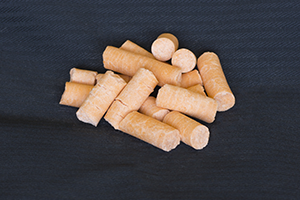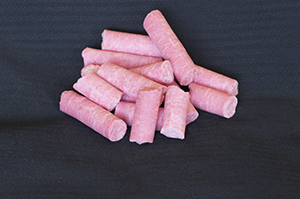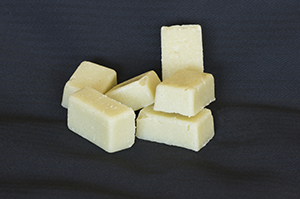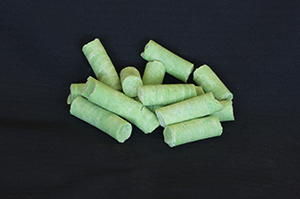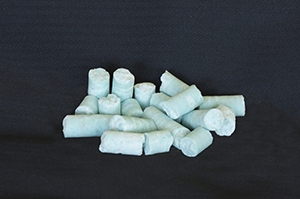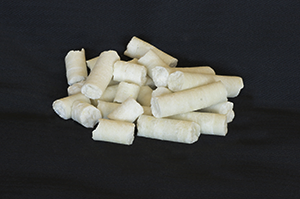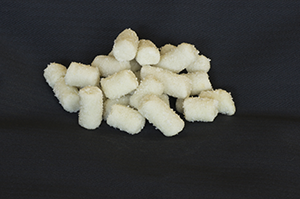Semi-Pure Control Diets
Back to Top
Semi-Pure Growth Diet AIN-93G

This diet is based on a formulation developed by the American Society of Nutritional Sciences: ASNS (formerly American Institute of Nutrition). The Diet AIN-93G was a modification of a prior formulation AIN-76A. This well studied diet was updated to separate maintenance from growing animals and improve the long term health of rodents fed semi-pure diets.
- The formulation for AIN-93G and AIN-93M was first presented in Journal of Nutrition., 123[11]:1939-51, November 1993,
- AIN93G is the growth form of this standard pure or semi-pure diet formulation.
- We have made some modifications of the formulation to suit locally available raw materials. Our experience in short and long term feeding trials confirms that these modifications have little or no impact on animal performance.
- Cystine in the original formulation has been replaced by methionine. Although casein has a low cystine content, there is good evidence of interconversion of methionine and cystine.
- Soybean oil has been replaced by Canola oil. While this changes the fatty acid profile of the diet all known requirements have been met. The biggest difference between soybean and canola oils is in the linoleic and linolenic acid content. Although canola oil has a lower linoleic acid content (a known essential fatty acid) it could be argued that the n6 / n3 fatty acid ratio of canola oil is superior to soybean oil. The erucic acid content of canola oils available in Western Australia is extremely low.
- Some minor modifications have been made in the salt form of the trace minerals.
- If your intention is to irradiate this diet at 25 KGy we recommend that you consider SF09-091
References:
Keywords: pure diet, semi-pure diet, control diet, growth, AIN93G, AIN, AIN93, AIN-93G
Semi-Pure Maintenance Diet (AIN-93M)
This diet is based on a formulation developed by the American Society of Nutritional Sciences: ASNS (formerly American Institute of Nutrition). The Diet AIN-93M was a modification of a prior formulation AIN-76A. This well studied diet was updated to separate maintenance from growing animals and improve the long term health of rodents fed semi-pure diets.
- The formulation for AIN-93G and AIN-93M was first presented in Journal of Nutrition., 123[11]:1939-51, November 1993,
- AIN93M is the maintenance form of this standard pure or semi-pure diet formulation.
- We have made some modifications of the formulation to suit locally available raw materials. Our experience in short and long term feeding trials confirms that these modifications have little or no impact on animal performance.
- Cystine in the original formulation has been replaced by methionine. Although casein has a low cystine content, there is good evidence of interconversion of methionine and cystine.
- Soybean oil has been replaced by Canola oil. While this changes the fatty acid profile of the diet all known requirements have been met. The biggest difference between soybean and canola oils is in the linoleic and linolenic acid content. Although canola oil has a lower linoleic acid content (a known essential fatty acid) it could be argued that the n6 / n3 fatty acid ratio of canola oil is superior to soybean oil. The erucic acid content of canola oils available in Western Australia is extremely low.
- Some minor modifications have been made in the salt form of the trace minerals.
- If you are considering irradiating this diet at 25 KGy we suggest that you consider SF08–020
References:
Keywords: pure diet, semi-pure diet, control diet, growth, AIN93M, AIN, AIN93
SF04-057 Semi-pure rodent diet

Low fat semi pure rodent diet. This diet was designed to be a control for SF00-219.
-
Total fat content has been reduced from 22% to 6%.
-
The lipid source has changed from Ghee to Canola oil. This was done to maintain the known requirements of some individual fatty acids.
-
Starch content was increased to match the removal of Ghee.
References:
Keywords: pure diet, semi-pure diet, control diet
SF16-074 Low fat control for SF04-027

A semi-pure low fat diet formulation for laboratory rats and mice based on Research Diets D12450B. Some modifications have been made to the original formulation to suit locally available raw materials and to balance ration against SF04-027.
-
Fat content has been reduced from 23% to 6%,
-
All fats replaced with canola oil
- Diet is a suitable control for SF04-027
References:
Keywords: pure diet, semi-pure diet, control diet, fat, SF04-027,
SF14-162 Semi Pure Control Diet Based on AIN93G

A semi-pure diet formulation for laboratory rats and mice based on AIN-93G. This formulation satisfies the nutritional requirements for growth of rats and mice. Some modifications have been made to the original formulation to suit locally available raw materials.
-
This formulation differs from Specialty Feeds AIN93G formulation as it uses Soyabean Oil Instead of Canola Oil.
- No Other changes have been made to the formulation.
Keywords: control diet,
SF00-252 50% Protein Modified Rodent Diet

A high protein, semi pure diet based on AIN93G.
- Protein concentration has been increased from 20% to 52%
- As a result of the increase in protein the calculated energy has increased by around 16% from 16.1 MJ/Kg to 18.2 MJ/Kg
- No other changes were made to the standard semi-pure diet, see data sheet for AIN93G for further information.
- A suitable control diet is AIN93G or AIN93M
Keywords:
SF01-026 8% Protein Modified Rodent Diet

A low protein, semi pure diet based on AIN93G.
- Protein concentration has been reduced from 20% to 8%.
- As a result of the reduction in protein the calculated energy has reduced by around 4%.
- No other changes were made to the standard semi-pure diet, see data sheet for AIN93G for further information.
- A suitable control diet is AIN93G or AIN93M
Keywords: protein deficient, low protein diet,
SF04-059 9% Protein Modification of AIN93G Rodent Diet

A semi-pure low protein modification of AIN93G.
-
Protein concentration has been reduced from 20% to 9%.
-
Modifications have also been made to inclusion rate of Potassium citrate, potassium sulphate and potassium dihydrogen phosphate to balance minerals found in casein.
-
Energy has been allowed to vary with differing protein content.
-
Starch content has been increased to make up the balance of the diet.
- A suitable control diet is AIN93G or AIN93M
Keywords: low protein,
SF04-060 14% Protein Modification of AIN93G Rodent Diet

A semi-pure low protein modification of AIN93G.
-
Protein concentration has been reduced from 20% to 14%.
-
Modifications have also been made to inclusion rate of Potassium citrate, potassium phosphate and potassium dihydrogen phosphate to balance minerals found in casein.
-
Energy has been allowed to vary with differing protein content.
-
Starch content has been increased to make up the balance of the diet.
- A suitable control diet is AIN93G or AIN93M
Keywords: low protein
SF03-018 60% Fructose semi-pure rodent diet.
A semi-pure diet formulation for laboratory rats and mice based on AIN-93G.
-
Sucrose, Dextrinised starch and starch have been replaced with fructose.
-
No reliable energy data was available for fructose. It has been assumed that fructose has an equivalent energy content to glucose.
- A suitable control diet is AIN93G or AIN93M
Keywords: hyperglycemia and glucose intolerance, insulin resistance
SF12-040 Non Auto Florescent Modification of AIN93G

A semi-pure diet formulation for laboratory rats and mice based on AIN-93G. This formulation satisfies the nutritional requirements for growth of rats and mice. Some modifications have been made to the original formulation to suit locally available raw materials.
- Cellulose has been removed from the die. Wheat starch has been increased to balance the diet. This diet has been shown to be non auto florescent.
Keywords: no autofluorescence, fluoresce, fluorescence imaging, fluorescent
SF03-023 Modified AIN93G Rodent Diet all CHO as Dextrose

A semi-pure diet formulation for laboratory rats and mice based on AIN-93G.
- All CHO is replaced with dextrose.
- No other modifications have been made.
- A suitable control diet is AIN93G or AIN93M
Keywords: high glycaemic index, high glycemic index, high dextrose
SF12-097 Modified AIN93G 10% Inulin

A semi-pure diet formulation for laboratory rats and mice based on AIN-93G.
-
Cellulose has been removed and replaced with 10% Inulin (FibreSure)
Keywords: Fibre, inulin, Mg2+ absorption, gastro-intestinal inflammation
SF11-025 Modified AIN93G all Carbohydrates as High Amylose Starch

A semi-pure diet formulation for laboratory rats and mice based on AIN-93G.
-
All CHO has been replaced with Gel Crisp (Crisp Film) starch.
-
Gel Crisp (Crisp Film) is a modified high amylose starch made from maize starch
Key words: Semi-pure, carbohydrate, amylose, resistant starch, fibre
Keywords: resistant starch,
SF11-029 High Fibre Semi-Pure Rodent Diet
A semi-pure diet formulation for laboratory rats and mice based on AIN-93G.
-
All CHO has been replaced with Wheat starch.
-
Cellulose has been increased to 20%
-
Guar Gum has been added at 20%
- The low fibre pair for this diet is SF09-028
- If your intention is to irradiate this diet at 25 Kg we recommend that you consider SF15-087
Keywords: dietary fibre, fiber, high fiber, semi-pure, high fibre, food allergy, inflammation, metabolite-sensing receptors, Colitis
SF13-055 Low Fibre Modification of AIN93G

A semi-pure diet formulation for laboratory rats and mice based on AIN-93G. This formulation satisfies the nutritional requirements for growth of rats and mice. Some modifications have been made to the original formulation to suit locally available raw materials.
- 1.15% Guar Gum, 1.15% Cellulose, Wheat Starch increased.
Keywords: low fiber, 2.3% fibre
Lipid Modifications
Back to Top
SF04-001 High Fat Rodent Diet Similar to D12451

A semi-pure high fat diet formulation for laboratory rats and mice formulated to be similar to Research Diets D12451. Some modifications have been made to the original formulation to suit locally available raw materials.
-
SF13-081 is the control diet for this formulation.
- SF16-001 is the extra vitamins version of this formulation for irradiation.
Download PDF Datasheet (25kb)
Keywords: cardiovascular disease model, atherosclerosis, high fat diet, atherosclerotic lesions, type 2 diabetes, metabolic syndrome, Obesity, hyperlipidaemia, hyperlipidemia,
SF00-219 22% Fat 0.15% Cholesterol ( “Western Diet”)
 A high fat diet for laboratory mice and rats formulated to mimic a “Western fast food diet”. This diet was designed to be equivalent to Teklad TD88137 or Research Diets Western Diet D12079B. Modifications have been made to suit available raw materials.
A high fat diet for laboratory mice and rats formulated to mimic a “Western fast food diet”. This diet was designed to be equivalent to Teklad TD88137 or Research Diets Western Diet D12079B. Modifications have been made to suit available raw materials.
- This diet was developed to generate arteriosclerotic lesions in a range of susceptible mouse strains.
- A suitable control diet is SF04-057
- This diet was designed around a set of obsolete vitamin inclusion specifications. We have designed a diet around the more recent vitamin specifications as SF05-031
- A modification suitable for irradiation is SF16-136
Keywords: western diet, cardiovascular disease model, type 2 diabetes model, metabolic syndrome model, diet-induced obesity, hyperlipidaemia, hyperlipidemia, heart disease
SF03-020 23% Fat, High Simple Carbohydrate 0.19% Cholesterol Semi-Pure Rodent Diet

A semi-pure diet formulation for laboratory rats and mice based on AIN-93G.
-
The fat content has been increased to 23%
-
Sucrose content has been increased to improve pellet strength
-
Starch content has been reduced.
-
Cholesterol has been added at 0.19%.
- A suitable control diet is AIN93G or AIN93M
- We have evidence that vitamin losses and other changes to the diet can occur during the irradiation process at 25KGy. Please contact us for more information if the diet is to be irradiated.
- If your intention is to irradiate this diet at 25 KGy we recommend that you consider SF16-096
- We also make a version of this diet, SF15-059 with banana flavour to improve palatability
Keywords: cardiovascular disease model, type 2 diabetes model, metabolic syndrome model, diet-induced Obesity, hyperlipidaemia, hyperlipidemia, atherogenic
SF03-030 23% Fat, High Glycaemic Index Semi-Pure Rodent
Diet

A semi-pure diet formulation for laboratory rats and mice based on AIN-93G. This formulation has been designed to maximise the risk of developing type II diabetes.
-
The only carbohydrates present are cellulose, as a fibre source, and dextrose. Theoretically the glycaemic index of this diet should be close to 100.
- A suitable control diet is AIN93G or AIN93M
References:
- Hodgson, K., Govan, B., Ketheesan, N. et al. Endocrine (2013) 43: 447. doi:10.1007/s12020-013-9874-5
Keywords: cardiovascular disease model, high fat diet, type 2 diabetes, heart disease
SF00-245 16% Fat 1% Cholesterol Semi Pure Rodent Diet

A high fat fixed formulation diet for laboratory rats and mice diet based on AIN93G.
- This diet was developed in collaboration with Judy DeHaan Klein (Institute of Reproduction and Development, Monash University).
- The diet relies heavily on two published papers ‘Synthetic low and high fat diets for the study of artheriosclerosis in the mouse’, Nishina et al, J Lipid Research Vol 31 1990 and ‘The mouse as a model for human cardiovascular disease and hyperlipidaemia’, Paigen et al. Current Opinion in Lipidology 1994, 5:258-264.
- Contains 0.5% Cholate and 1% Cholesterol.
- A suitable control diet is AIN93G or AIN93M
- We have received reports of a reduction in feed intake after prolonged feeding with some strains. This can be overcome by the use of food flavourings.
- In mouse model systems fat deposition is usually evident with 10 weeks.
Keywords: cardiovascular disease model, atherosclerosis, high fat diet, high cholesterol diet, hypercholesterolemia, atherosclerotic lesions, heart disease
SF00-229 5% Fat Modified Rodent Diet
A reduced fat modification of the semi-pure diet formulation AIN93-G, for laboratory rats and mice based on AIN-93G.
- The only modification of this diet is a small reduction in fat from 7% to 5%.
- This change has resulted in a 2% reduction in calculated energy
- Feed is manufactured as a 12 mm diameter cube, vacuum packed.
Keywords: pure diet, semi-pure diet, control diet, growth,
SF02-006 60% Fat Modified Rodent Diet
A very high fat fixed formulation diet based on AIN93G rat and mouse.
- The high fat content has resulted in a 74% increase in calculated energy. To allow for the high fat inclusion, the carbohydrate content has been reduced.
- The fatty acid profile has an increased proportion of saturated and monounsaturated fats.
- Changes in all other nutritional parameters have been kept to a minimum.
- In one research facility this formulation induced clear evidence of insulin resistance after six weeks feeding.
- The high fat content has necessitated a change in the diet from away from a pellet to a small block. The block contains around 25 grams of diet and can be fed “as is” or cut into smaller sections for feeding.
- A suitable control diet is AIN93G or AIN93M
Keywords: cardiovascular disease model, atherosclerosis, high fat diet, high cholesterol diet, hypercholesterolemia, atherosclerotic lesions, heart disease
SF03-002 36% Fat Modified Rodent Diet

A very high fat semi-pure diet formulation for laboratory rats and mice based on AIN-93G.
-
Total fat content has been increased to 36% fat. Using generally recognised energy data this would equate to a diet where 59% of total energy is from lipids.
-
The fats included to make up the total fat content have been chosen to maximise diet palatability whilst retaining a good spread of fatty acids. All known fatty acid requirements have been met or exceeded.
-
We would recommend that this diet be transported and stored at less than 15oC. At higher temperatures the diet softens considerably.
-
Calculated digestible energy has increased as a result of the increased fat inclusion.
-
Dietary carbohydrate content is from sucrose only. All starch has been removed from the diet. This has been done primarily to improve pellet strength but may also have some physiological implications.
-
See data sheet SF14-154 additional vitamins for irradiation modification of SF03-002
- A suitable control diet is AIN93G or AIN93M
- If your intention is to irradiate this diet at 25 Kg we recommend that you consider SF14-154
Keywords: cardiovascular disease model, atherosclerosis, high fat diet, high cholesterol diet, hypercholesterolemia, atherosclerotic lesions, heart disease
SF01-028 23% Fat Modified Rodent Diet

A high fat semi-pure diet based on AIN93G.
- Fat content has been increased from around 7% in AIN93G to 23%.
- Calculated energy has increased by around 24% over the base diet. 40% of the total calculated energy is from lipids.
- The triglyceride profile has an increased proportion of saturated and monounsaturated fatty acids over the standard diet.
- Other nutritional parameters have remained unchanged.
- The high fat content has resulted in a significant reduction in pellet hardness. The pellets must be handled with great care to avoid breakage.
- A suitable control diet is AIN93G or AIN93M
Keywords: cardiovascular disease model, atherosclerosis, high fat diet, high cholesterol diet, hypercholesterolemia, atherosclerotic lesions, heart disease
SF04-025 High Lard Modification of AIN76 Semi-Pure Rodent Diet

A semi-pure high fat diet formulation for laboratory rats and mice based on AIN76. Some modifications have been made to the original formulation to suit locally available raw materials.
-
20% Lard has been added to the formulation in place of Canola oil,
-
Sucrose inclusion has been increased
- Starch inclusion has been decreased
- Sodium Cholate has been added at 0.1%
- Cholesterol has been added at 0.5%
Keywords: cardiovascular disease model, atherosclerosis, high fat diet, high cholesterol diet, hypercholesterolemia, atherosclerotic lesions,
SF04-027 23% Fat Semi-Pure Rodent Diet Based on D12451

A semi-pure high fat diet formulation for laboratory rats and mice based on Research Diets D12451. Some modifications have been made to the original formulation to suit locally available raw materials.
-
Fatty acid profile of this diet has been modified from D12451 specifications. Lard and Soya Oil have been replaced with Cocoa Butter, Hydrogenated Vegetable Oil and Canola Oil.
-
46% of total calculated energy is from lipids, 20% of total calculated energy from protein and the remainder from carbohydrates.
- The Low Fat Control for this diet is SF16-074
-
We have evidence that vitamin losses can occur during irradiation at 25KGy. Please contact us for more information if the diet is to be irradiated.
Keywords: high fat diet, metabolic syndrome, Obesity, hyperlipidaemia, hyperlipidemia,
SF10-053 69% Fat Ketogenic TD96355 Equivalent Rodent Diet

A very high fat very low carbohydrate semi-pure diet formulation for laboratory rats and mice equivalent to Harlan Teklad Diet TD.96355 some modifications have been made to suit locally available raw materials.
- Total fat content has been increased to 69% fat. Using generally recognised energy data this would equate to a diet where 89% of total energy is from lipids.
- The fats included to make up the total fat content have been chosen to maximize diet palatability whilst retaining a good spread of fatty acids. All known fatty acid requirements have been met or exceeded.
- We would recommend that this diet be transported and stored at less than 15oC. At higher temperatures the diet softens considerably.
- Calculated digestible energy has increased as a result of the increased fat inclusion.
- No Dietary carbohydrates have been added
- Vitamin and mineral inclusion rate has been increased.
- Feed is manufactured as a 15 mm x 20 mm block set in trays.
- A suitable control diet is AIN93G or AIN93M
Keywords: ketogenic diet, low carbohydrate, high fat, high protein
Mineral Modifications
Back to Top
SF01-017 Low Iron, Semi-Pure Rodent Diet

A semi-pure diet formulation for laboratory rats and mice based on AIN-93G.
- Iron content has been decreased to <10 mg Fe / Kg diet by exclusion of any added Fe to the
trace mineral premix. - In addition higher purity minerals have been used to minimise trace level contamination of
iron in this raw material. - The careful selection of raw materials has allowed us to reduce dietary in this diet from what
was previously achieved. Recent analysis of this diet (in powder form) has shown that the
average Fe level in this diet is 2.5mg/Kg - The generally recognised minimum iron requirement in rats and mice is 35 mg Fe / Kg diet for
maintenance and growth and 75 mg Fe / kg diet during pregnancy and lactation. Diets
showing clear symptoms of iron deficiency are generally in the range of 2 – 10 mg Fe / Kg
diet. - Whilst this diet has an iron concentration less than known requirements, it was not designed
as a diet leading to rapid symptoms of iron deficiency. - The pelletised diet has an increased iron content than the powder form. Typically in the
range of 15 – 20 mg Fe / Kg. - A suitable control diet is AIN93G or AIN93M
- This diet is the base diet for a number of controlled Fe diets, including SF07-082 with 2% Carbonyl Iron
Keywords: low iron, no iron, low Fe,
SF01-027 Low Zinc Semi Pure Rodent Diet

A semi-pure diet formulation for laboratory rats and mice based on AIN-93G.
- Zinc content has been reduced by excluding any additions in the trace mineral premix.
- A considerable quantity of zinc is present as trace level contaminants in the casein, starch and cellulose. The calculated zinc concentration of this diet is around 20 mg / Kg. Analyses confirm this concentration.
- At this concentration it would exceed the generally recognized maintenance and growth requirements for most strains of mice and rats. However zinc requirements during lactation and pregnancy are thought to be around 30 mg / Kg.
- It should be possible to further reduce dietary zinc concentration by careful selection of casein, starch and cellulose sources or finding alternative protein and carbohydrates.
- Feed is manufactured as a 12 mm diameter cube, vacuum packed.
- A suitable control diet is AIN93G or AIN93M
Keywords: zinc deficient, zinc deficiency
SF06-016 – Zinc Limiting Modification of AIN93G Rodent Diet

A semi-pure diet formulation for laboratory rats and mice based on AIN-93G. Raw materials were
selected to minimise zinc content.
- Casein was replaced with whey protein isolate at same inclusion rate.
- Analysis reports around 3 mg Zn / Kg feed.
- A suitable control diet is AIN93G or AIN93M
Keywords: low Zinc, zinc deficient,
SF02-020 0.02% Sodium, 0.07% Chloride Semi Pure Rodent Diet

A fixed formulation semi pure diet based on AIN93G rat and mouse, modified to reduce sodium content but retain chloride above generally recognised minimum levels.
- The macro mineral and trace mineral additions to this diet have been selected to minimize sodium and chlorine. A small amount of sodium is present in the casein and starch components of the formulation.
- Sodium chloride is added back to the low Na base diet to control Na content at 0.02%.
- Potassium Chloride is used to adjust Cl content to greater than generally recognised minimum.
- Feeding studies indicate that the diet is deficient in sodium for conventional mouse strains.
- See also diet SF01-030.
- A suitable control diet is AIN93G or AIN93M
Keywords: low sodium, sodium deficient,
SF03-010 3.1% sodium semi-pure rodent diet.

A high sodium chloride semi pure diet based on AIN93G.
-
Sodium Chloride has been added at a concentration of 8%.
-
Sucrose has been increased to 20%
-
Wheat Starch has been reduced
-
No other changes were made to the standard semi-pure diet, see data sheet for AIN93G for further information.
- A suitable control diet is AIN93G or AIN93M
Keywords: high salt, 8% salt
SF05-023 5% NaCl Modified AIN93G Rodent Diet

A semi-pure diet formulation for laboratory rats and mice based on AIN93G. This formulation satisfies the nutritional requirements for growth of rats and mice. Some modifications have been made to the original formulation to suit locally available raw materials. Sodium chloride has been increased to 5g per 100gm of diet.
- A suitable control diet is AIN93G or AIN93M
- We also have a similar modification of AIN93M with 5% salt as SF05-038
Download PDF Datasheet (25kb)
Keywords: high salt, high sodium, high sodium chloride
SF05-023 5% NaCl Modified AIN93G Rodent Diet

A semi-pure diet formulation for laboratory rats and mice based on AIN93G. This formulation satisfies the nutritional requirements for growth of rats and mice. Some modifications have been made to the original formulation to suit locally available raw materials. Sodium chloride has been increased to 5g per 100gm of diet.
- A suitable control diet is AIN93G or AIN93M
- We also have a similar modification of AIN93M with 5% salt as SF05-038
Download PDF Datasheet (25kb)
Keywords: high salt, high sodium, high sodium chloride
SF06-016 – Zinc Limiting Modification of AIN93G Rodent Diet

A semi-pure diet formulation for laboratory rats and mice based on AIN-93G. Raw materials were
selected to minimise zinc content.
- Casein was replaced with whey protein isolate at same inclusion rate.
- Analysis reports around 3 mg Zn / Kg feed.
- A suitable control diet is AIN93G or AIN93M
Keywords: low Zinc, zinc deficient,
Vitamin Modifications
Back to Top
SF03-009 Semi-pure Rat and Mouse diet with no added Vitamin D

A semi-pure diet formulation for laboratory rats and mice based on AIN-93G.
-
Vitamin D has been excluded from the vitamin premix used in this diet
- No other modifications have been made to mitigate mineral metabolic impact
- A similar modification of AIN93M is manufactured as SF05-064
- A suitable control diet is AIN93G or AIN93M
Keywords: no vitamin d, vitamin d deficient,
SF05-033 – Low Vitamin D Semi-Pure Rodent Diet

A semi-pure diet formulation for laboratory rats and mice based on AIN-93G. This diet replaces
SF04-021 due to problems with pelleting.
-
- No vitamin D has been added to this ration.
- Calcium, Phosphorous and Magnesium have been increased in this ration over the standard
AIN93G diet. - The control for this ration is SF05-034
Keywords: low vitamin D, vitamin D deficiency, vitamin D3 deficiency,
Medicated Laboratory Animal Diets
Medications can be incorporated into almost any diet. Examples of common medications include:
- Addition of Fenbendazole to rodent diet for the control of pin worm.
- Addition of coccidiostats to rabbit, poultry or ruminant diets.
In our large scale plant the only medication we use is Fenbendazole. Following manufacture of fenbendazole diets we have a rigorous cleaning procedure aiming to eliminate residual medication.
Our small scale plant is specifically designed so that it can be taken apart and cleaned thoroughly between batches of feed, this reduces the risk of cross contamination. In this plant we can incorporate almost any drug into diets, with some restrictions to ensure the safety of our staff.
In Australia a veterinary prescription is required for the incorporation of medications into feeds.
Back to Top
Pure Amino Acid Diets (Including Methionine Choline Deficient Diets)
SF14-170 Replete Pure Amino Acid Diet

A semi-pure diet formulation for laboratory rats and mice using purified amino acids.
-
Diet replete in all amino acids based on AIN93G Specification
-
Individual amino acids inclusion rate is as reported by Gahel et al. (1991)
Keywords: amino acid, control,
SF05-016 Low Choline Low Methionine 25% Fat Rodent Diet

A semi-pure diet formulation for laboratory rats and mice using purified amino acids and using olive oil as the lipid source.
- A suitable control diet is SF14-170.
Keywords: choline deficient, methionine deficient, nonalcoholic steatohepatitis, mcd, methionine choline deficient, CDHFD
SF14-109 20% Fat Choline deficient with DL-Ethionine

A semi-pure diet formulation for laboratory rats and mice based on MP’s Choline Deficient Diet with DL-Ethionine. Some modifications have been made to the original formulation to suit locally available raw materials.
- Formulation uses Specialty Feeds AIN93 Minerals and AIN93 Vitamins
- Choline chloride and dl methionine have been excluded from the formulation
- A suitable control diet is SF14-170.
Keywords: choline deficient, methionine deficient, nonalcoholic steatohepatitis, mcd, methionine choline deficient, ethionine
SF14-169 Low Phenylalanine Purified Amino Acid Modification of AIN93G

A semi-pure diet formulation for laboratory rats and mice using purified amino acids.
-
Low Phenylalanine purified amino acid diet based on Ain93G specifications.
-
Individual Amino Acid inclusions rates based on inclusion rates reported by Gahel et.al (1991)
- A Suitable Control is SF14-170
Keywords: phenylketonuria, pku, PKU, amino acid, phenylalanine, tyrosine
SF13-136 Low Choline Low Methionine

A semi-pure diet formulation for laboratory rats and mice using purified amino acids.
-
Diet is low in Choline and Methionine
-
10% fat from corn oil
-
Diet is equivalent to TD 90262
-
Control for this diet is SF13-137
Keywords: Amino Acid, choline, methionine, fatty liver, non-alcoholic steatohepatitis
Semi-Pure Gelform diets
SF15-106 Semi-Pure Dough Recover Diet
A semi-pure diet formulation for laboratory rats and mice based on AIN-93G.
- Diet supplied as powder to be mixed with water to make dough by facility. To 20g of diet add 8g of water kneed into dough.
- Diet is supplemented with Peanuts, Dextrose and Sodium Caseinate to make diet more palatable during recovery
Keywords: sf14-156, sf15-106, semi, pure, dough, recovery, medicated
SF17-112 Semi-pure Gelform Diet

A semi-pure diet formulation for laboratory rats and mice designed to be nutritionally equivalent to Bioserv Nutrigel F5769. This formulation satisfies the nutritional requirements for growth of rats and mice. Some modifications have been made to the original formulation to suit locally available raw materials.
- Vitamins have been increased to allow for some loss on irradiation.
- A suitable control diet is AIN93G
Directions for use
- Mix 200g Powder with 300g Water heated to 60°C, mix for 3 minutes
- Pour mixture into cavity trays
- Put trays in Refrigerator to set
- Store product in Refrigerator in a sealed container until use. Use within one week
Keywords:vitamin D deficient, low vitamin D, low cholecaciferol
